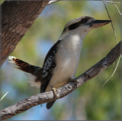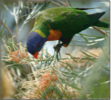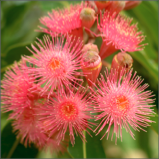Local North Queensland information for Local North Queenslanders.
To get birds to live in your garden permanently you have to provide both food and shelter to hide from predators and to nest…
 Everyone wants to attract birds to their garden! It’s easy to plant some grevilleas and get a few honeyeaters to visit occasionally, but how do you attract a bigger variety of birds, and how do you get them to actually stay and set up home at your place?
Everyone wants to attract birds to their garden! It’s easy to plant some grevilleas and get a few honeyeaters to visit occasionally, but how do you attract a bigger variety of birds, and how do you get them to actually stay and set up home at your place?
To get birds to live in your garden permanently you have to provide both food and shelter to hide from predators and to nest. As a general rule, birds don’t nest in their food plants (the same as we don’t usually sleep in our kitchens!). So, in addition to providing plants which produce nectar (for honeyeaters) or fruit (for fruit-eaters), you also need to plant lots of general plants for insects, shelter and nesting. These can be any native plant really, but plants which are thick and bushy, or prickly, are particularly good for this purpose.
Attracting Honeyeaters:
Honeyeaters are easy to attract. Simply plant natives such as grevilleas and callistemons which produce lots of flowers with nectar all year round. If you want them to stay in your garden and nest, then provide a range of other species for them to shelter in. Actually, honeyeaters feed their young on insects, so they will not nest in your yard unless you have a garden with a range of other plants that they can forage through for insects. Both insect-eaters and honeyeaters make a huge contribution towards controlling unwanted insect pests in your garden.
Attracting Insect-eaters:
Just about all bushy plants will provide a source of insects. Don’t spray with chemicals – let the birds do it for you. Plant a large variety of plant species to ensure a big selection of insects. Insect-feeders tend to be small birds, but often they have very beautiful songs.
Attracting Fruit-eaters:
Fruit-eating birds come and go with the seasons and the food supply. These birds are usually highly mobile and visit a garden on ‘raiding parties’ when a particular fruit is ripe. This means that you will have different types of birds as various types of fruits mature. One of these, the Coel Cuckoo or Storm Bird, is the sound of summer in the north.
Don’t Forget the Carnivores:
 It’s not an Australian garden without kookaburras! And don’t forget the owls and other carnivores.
It’s not an Australian garden without kookaburras! And don’t forget the owls and other carnivores.
They are great to have around to control rats and snakes. Attract them to your garden by planting trees with nesting spots and branches to sit on, with lots of bushy plants and leaf litter to harbour lizards, mice, bandicoots and other creatures.
So you can see that it is easy to have a garden full of a wide variety of bird life, by planting a wide variety of plants to produce nectar and fruit, harbour insects, and provide shelter and nesting spots. Plant your plants in garden beds. Individual specimens are rarely attractive to native birds, since they do not provide shelter.
Getting Started:
To get started, plant some honeyflora, ie plants whose flowers produce a lot of nectar. It is amazing how quickly the honeyeaters will come. Include a wide variety of other natives in your planting, and especially lots of bushy tropical natives such as lilly-pillies. Then you’ll get the insect-eaters, and the fruit-eaters when the fruit are on. And eventually some owls when the plants have grown up.
Native Gardens Attract Native Birds
It is now widely recognised that balanced native gardens attract native birds to the exclusion of pest birds such as Sparrows and Indian Mynahs. The secret is to create a garden in which sufficient native birds live permanently so that introduced pests cannot establish. A good rule of thumb is a garden of about an acre comprised of at least 80% native plants (measured in terms of total bio-mass). If you have a small yard, you can achieve the same result by encouraging your neighbours to plant natives. After all, birds don’t see fences and boundaries.
It works! At Yuruga, we are surrounded by farming land with a large population of Mynah birds, and yet we have never had these pest birds in our gardens. The resident native birds drive them out! And we have a wonderful array of native birdlife in our gardens all year round.
A Ballanced Native Garden
 A balanced garden is one in which pests and diseases are under control by natural means, with little or no need to resort to chemical sprays.
A balanced garden is one in which pests and diseases are under control by natural means, with little or no need to resort to chemical sprays.
There are two main requirements in order to achieve this balance:
- a wide range of species, and
- an adequate proportion of honeyflora to attract birds
A wide range of species is essential since mono-culture situations are havens for pests, as any farmer growing a paddock of one crop knows only too well.
As soon as you plant several of the same species in close proximity in the garden, you are inviting trouble. It is just so much easier for pests to find a plant when you advertise the fact by planting a whole heap of them together.
So, confound the critters! Make life hard for them! Plant a huge mixture of different plants, or if you have a favourite plant that you just have to have several in your garden, then spread them out all over the place and make it difficult for the bugs and beasts to find them.
Secondly, honeyflora is essential in order to attract honeyeaters which are brilliant natural pest-controllers since a large portion of their diet is insects.
Honeyflora plants are those whose flowers produce a lot of nectar, ie traditional natives such as bottlebrushes, melaleucas, grevilleas, tea-trees and eucalypts.
However, with our warm tropical climate and the lush growth that accompanies it, honeyflora plants grow very fast and are prone to becoming leggy and sparse (a common problem with melaleucas and tea-trees) or even out-growing themselves and dying before time (grevilleas are notorious for lasting only about 5 years or so).
Tropical native species such as Lilly-pillies are more suited to our climate in the long run, since they are permanent, have lush tropical foliage, a dense, shapely habit, provide shade and coolness and make excellent screens for wind and privacy.
Honeyflora
 To get the best out of honey-flora species, they must be planted in an open, full-sun position to ensure good flowering and a bushy habit.
To get the best out of honey-flora species, they must be planted in an open, full-sun position to ensure good flowering and a bushy habit.
Nevertheless, the inclusion of at least some honeyflora in the garden is absolutely essential in order to provide an all year round source of nectar so that there is a permanent bird population and permanent means of pest control.
So plant your garden to include honeyflora as well as tropical natives (such as lilly pillies etc). A good balance is about 75% tropical natives and about 25% honeyflora.
Plant the honeyflora in a position that is in the full sun now, and which will remain in the full sun even after the rest of the garden has grown.
 Bear in mind that the honeyflora species may need replacing in a few years time and so plant them in a spot where it is easy to do this.
Bear in mind that the honeyflora species may need replacing in a few years time and so plant them in a spot where it is easy to do this.
At Yuruga, we virtually never use chemical sprays in the garden. We have a permanent population of honeyeaters which feed on nectar from the grevilleas and bottlebrushes (there’s always something in flower) and which flit all through the branches and foliage of the other plants in the gardens feeding on insects and other pests, as well as seeking out shelter and nesting sites.

